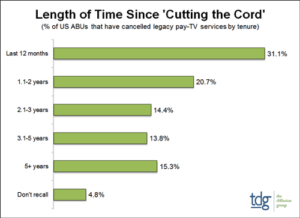According to TDG research, one-third of US-based cord-cutters cancelled their legacy pay-TV service in 2016, and 52% of cord-cutters cancelled their legacy pay-TV service in the two calendar years of 2015 and 2016. These figures are from the TDG report, Life Without Legacy Pay-TV: A Profile of US Cord Cutters and Cord Nevers. TDG expects that cord-cutting will continue this year.
Michael Greeson, co-founder and principal at TDG, believes that the increase in cord-cutting is due to the high prices of legacy pay-TV and the low prices of on-demand streaming services like Netflix and Amazon Prime. Another factor is that video streaming has evolved to include a growing variety of live linear services that mirror in many ways the offerings of legacy providers, but are customised to the needs of individual viewing segments. Also, consumers now have greater flexibility in deciding for themselves which channels they receive and pay for.
Most of the incumbents are now offering lower priced bundles without understanding the long-term consequences of this strategy. Comcast is an exception and is an example of a company doing well in this new age of ‘quantum media’. Most of the incumbents have resigned themselves to being a dumb-pipe provider, whereas Comcast has invested in using IP, changed the TV experience, and become the go-to source for all things video. As a consequence, Comcast is now gaining video subscribers when others are reporting loses, TDG believes.
Showing length of time since US consumers cut the cord

